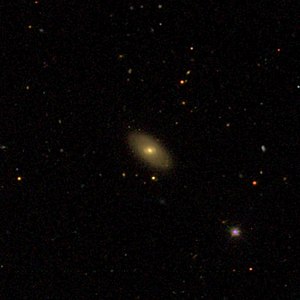IC 1761
| Galaxy IC 1761 |
|
|---|---|

|
|
| SDSS recording | |
| AladinLite | |
| Constellation | whale |
|
Position equinox : J2000.0 , epoch : J2000.0 |
|
| Right ascension | 01 h 58 m 52.3 s |
| declination | + 00 ° 34 ′ 06 ″ |
| Appearance | |
| Morphological type | S0-a |
| Brightness (visual) | 14.4 mag |
| Brightness (B-band) | 15.3 mag |
| Angular expansion | 0.90 × 0.5 |
| Position angle | 45 ° |
| Surface brightness | 13.4 mag / arcmin² |
| Physical data | |
| Redshift | 0.023368 ± 0.000086 |
| Radial velocity | 7006 ± 26 km / s |
|
Stroke distance v rad / H 0 |
(315 ± 22) · 10 6 ly (96.5 ± 6.8) Mpc |
| history | |
| discovery | Lewis Swift |
| Discovery date | October 2, 1886 |
| Catalog names | |
| IC 1761 • PGC 7484 • CGCG 387-019 • 2MASX J01585227 + 0034058 • GALEX ASC J015852.19 + 003405.8 | |
IC 1761 is a lenticular galaxy of the Hubble-type S0 / a in the constellation Cetus south of the celestial equator . It is an estimated 315 million light years from the Milky Way and about 80,000 light years in diameter . Together with NGC 768 , it forms a gravitationally bound galaxy pair.
In the same area of the sky are u. a. the galaxies IC 175 and IC 177 .
The object was discovered by Lewis Swift on October 2, 1886 .
